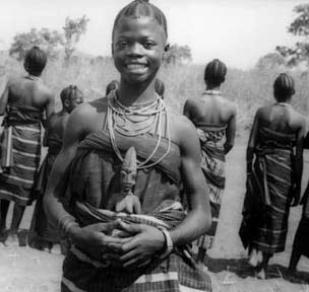
Yoruba Twins, Nigerian, Ere Ibeji
Pair of Non-Identical Ibeji Twins (Ere Ibeji)
Yoruba People, Oyo Region
Nigeria
circa 1950
height: 27cm (male), 27.5cm (female)
This pair of ibeji twins (ibeji means ‘born two’) stands with their hands on their hips and with slightly bent knees. Typically, their heads are over-sized – one-third the size of their bodies – because for the Yoruba, the head is where the spirit resides.
Their tall blue coiffures are decorated with finely carved bands of chevron ornaments and round topknots. They have thin smiling lips, fine ears and delicate noses. Their almond-shaped eyes are half-closed; their eyelids are thick and heavy. Their faces have a lighter patina due to wear. Two sets of vertical scarification are on their cheeks. The male twin has cowries hanging from his right wrist, and the female has a metal bracelet around her right wrist.
Tukula powder is applied heavily to the bodies. Tukula was ground from tukula wood and used as both a cosmetic and for protection from insects and from the sun. Tukula was also believed to have healing properties and magical powers.
Rekitts Blue, much used in the 19th century and early 20th century, has been applied to the hair of both. (Rekitts Blue was a washing soda coloured with a blue aniline dye and was widely used as a source of blue pigment in many nineteenth tribal societies from South American Indians, across Africa, and to the aboriginal people of Australia.)
The finely carved platform sandals of both are highly unusual, and add to the sculptural properties of the pair.
As with all ibeji twins, this pair are carved as adults, which is common in African sculpture. Though meant to represent children, their features are more mature, including scarifications on the face, full pointy breasts on the female and a prominent penis on the male.
This pair has a dark, glossy patina and contours that have been soften from ritualistic use.
Why is twin depiction so prevalent in Yoruba art forms? Giving birth to twins is common among the Yoruba. In fact, they are believed to have the highest dizygotic (non-identical) twinning rate in the world. The births of twins amongst Yoruba women are four times more prevalent than anywhere else in the world.
The Yoruba believe that twins share the one soul. If one twin dies, the balance of the soul will be troubled. Due to high infant mortality,
ibeji figures were carved as spiritual representations of the dead twins. These figures were commissioned from village carvers. Usually they were placed in the living area of the house and fed, bathed and dressed regularly. (The practice is not unlike the treatment of images of Hindu gods in Hindu households in India.) These figures are particularly special to the mother, who keeps them close to her and caresses them in a loving manner. Rituals and prayers are performed for the child’s birthday and other celebrations or festivals.
Traditionally, the parents would visit a priest called a babalawo to determine the wishes of the deceased twin or twins. Special names were given to each twin. The first twin is often named Taiyewo or Tayewo which means ‘the first to taste the world’, names which are often shortened to Taiwo, Taiye or Taye. The last born twin traditionally is named Kehinde.






The Yoruba believed that Kehinde sends Taiyewo to find out what life is like on earth and in this way Taiyewo becomes the first child to be born. Taiyewo then communicates with Kehinde via his cries, explaining whether life is likely to be good or not. If Taiyewo determines that it will not be good then both of them will return from where they have come. Kehinde is considered the true elder of the twins despite being the last to be born. Kehinde is referred to as Omokehindegbegbon, ‘the eldest child who came last’, because of the privilege of sending Taiyewo on an errand. On the other hand, Taiyewo is referred to as Omotaiyelolu, ‘the child who first came to taste life’.
In this way, the ibeji twins here are representations of Kehinde and Taiyewo, proxies for them and the means by which their soul can be appeased.
Today, the Yoruba people form one of the largest tribes in west Africa. They number around 30 million and are predominant in Nigeria where they comprise 21 per cent of the population. Most Yoruba speak the Yoruba language. Today, 60 per cent are Christians and another 30 per cent are Muslims. But many, especially in rural areas, still practise old Yoruba traditions such as those based around ifa and orisha ibeji (twin worship).
References
Bacquart, J. B., The Tribal Arts of Africa, Thames & Hudson, 1998.
Fagg, W. & Pemberton, J. III., Yoruba: Sculpture of West Africa, Collins, 1982.
Rowland, A., Drewal, H. J. & Pemberton, J. III., Yoruba: Art and Aesthetics, Museum Rietberg, Zurich, 1991.
Provenance
Acquired from a UK collection.
Inventory no.: 886
SOLD



